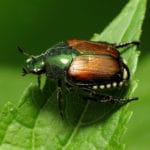THE REPRODUCTIVE CYCLE

Japanese Beetle
The Japanese beetle has a one-year life cycle but spends most of its life in the soil as a grub. In spring, the overwintering, partially grown grubs move upward in the soil. From mid-May to June, the young larvae pupate. After pupating, adults begin to emerge from late-June to August. The female Japanese beetles release a pheromone that attracts males, causing them to congregate in groups. Mating and egg laying begins soon after emergence. Japanese beetle adults feed during the day on a wide variety of low-growing plants and later fly to tree leaves. Adults typically live for 30 to 45 days. Once mated, females lay eggs in the lawn and other grassy areas just under the soil surface. Eggs soon hatch and young larvae begin to feed on roots of nearby grass and other plants until cold weather forces them to move deeper into the soil for the winter. As the soil temperatures warm in the spring, the grubs return to the surface to complete their life cycle.

Masked-Chafer Beetle
Annual white grubs have a one-year life cycle. Adult chafer beetles are attracted to vigorously growing turf with damp soil, where they lay their eggs in July. The grubs hatch and feed on decaying organic matter and sod roots until October. When temperatures begin to drop, they tunnel downward in the soil to overwinter. In spring, the grubs move up in the soil and resume feeding. They pupate in May and emerge a few weeks later as adult chafer beetles.





